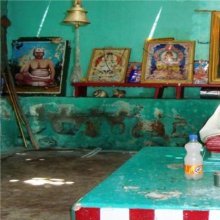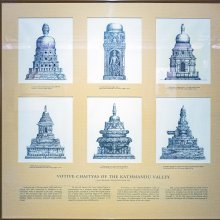Oblation: 3 definitions
Introduction:
Oblation means something in Hinduism, Sanskrit. If you want to know the exact meaning, history, etymology or English translation of this term then check out the descriptions on this page. Add your comment or reference to a book if you want to contribute to this summary article.
Images (photo gallery)
In Hinduism
Shaktism (Shakta philosophy)
Source: Brill: Śaivism and the Tantric Traditions (shaktism)Oblations (into the fire) formed a part of the Navarātra Tantric ritual (an autumnal festival of the warrior goddess Caṇḍikā).—The first seven days involve: kalaśapūjā (worship of deities including the goddess, the Mothers and waters from the sacred fords in a vase); a king bathing in the sanctified waters from the kalaśapūjā; fasting, worshiping Śiva thrice daily, animal sacrifice (paśubali); daily worship of the royal horses; fire oblations and feeding a maiden.—Various 8th century sources refer to rituals such as Fire oblations, for example: Devīpurāṇa, Kālikāpurāṇa, Kṛtyakalpataru, Durgābhaktitaraṅgiṇī, Durgāpūjātattva, Durgāpūjāviveka, Bhadrakālīmantravidhiprakaraṇa in Sanderson (2007); account of the Durgā Pūjā in Kelomal, West Bengal (Nicholas 2013).

Shakta (शाक्त, śākta) or Shaktism (śāktism) represents a tradition of Hinduism where the Goddess (Devi) is revered and worshipped. Shakta literature includes a range of scriptures, including various Agamas and Tantras, although its roots may be traced back to the Vedas.
Ayurveda (science of life)
Veterinary Medicine (The study and treatment of Animals)
Source: Asian Agri-History: Paśu Āyurvēda (Veterinary Medicine) in GaruḍapurāṇaOblation (in Sanskrit: bali) is used in the treatment of elephants (Gajāyurveda or Hastyāyurveda), according to the Garuḍapurāṇa.—[...] The worship of Sūrya (Sun), Śiva, Durgā, Śri Viṣṇu was for protection of the elephant. bali (Oblations), offerings must be given to Bhūta and the elephant must be bathed with caturghaṭa (four pitcherfuls) of water. The diet consecrated by reciting the proper mantras shall be given to the elephant and the elephant must be smeared with holy ashes. The sacred rites act against the influences of malignant spirits and grant immunity.

Āyurveda (आयुर्वेद, ayurveda) is a branch of Indian science dealing with medicine, herbalism, taxology, anatomy, surgery, alchemy and related topics. Traditional practice of Āyurveda in ancient India dates back to at least the first millenium BC. Literature is commonly written in Sanskrit using various poetic metres.
Natyashastra (theatrics and dramaturgy)
Source: Shodhganga: Elements of Art and Architecture in the Trtiyakhanda of the Visnudharmottarapurana (natya)Oblations (for offering) are associated with Mukula-hasta: one of the twenty-two Single-hand Gestures (in Indian Dramas) (known as asaṃyuktahastas), according to the Viṣṇudharmottarapurāṇa, an ancient Sanskrit text which (being encyclopedic in nature) deals with a variety of cultural topics such as arts, architecture, music, grammar and astronomy.—The Viṣṇudharmottarapurāṇa suggests that the tips of all fingers of the hand should be joined together to make this posture. When the tips of all fingers are joined together, it makes a shape of a blooming bud. [...] The posture mukula-hasta is formed to show the activities like worshiping of deities and offering oblations. Moreover, to show the lotus flower this hand posture is suggested to be used in dance performance in the Viṣṇudharmottarapurāṇa.

Natyashastra (नाट्यशास्त्र, nāṭyaśāstra) refers to both the ancient Indian tradition (shastra) of performing arts, (natya—theatrics, drama, dance, music), as well as the name of a Sanskrit work dealing with these subjects. It also teaches the rules for composing Dramatic plays (nataka), construction and performance of Theater, and Poetic works (kavya).
See also (Relevant definitions)
Ends with: Fire oblation.
Full-text (+1735): Ahuti, Huta, Bali, Purodasha, Havya, Havis, Hotriya, Homa, Agnihotra, Hotra, Havishya, Havana, Hutahoma, Svaha, Vashat, Yaga, Homakunda, Yajna, Makha, Balidana.
Relevant text
Search found 191 books and stories containing Oblation; (plurals include: Oblations). You can also click to the full overview containing English textual excerpts. Below are direct links for the most relevant articles:
Satapatha-brahmana (by Julius Eggeling)
Kāṇḍa XI, adhyāya 5, brāhmaṇa 2 < [Eleventh Kāṇḍa]
Kāṇḍa XIII, adhyāya 3, brāhmaṇa 4 < [Thirteenth Kāṇḍa]
Kāṇḍa XI, adhyāya 1, brāhmaṇa 3 < [Eleventh Kāṇḍa]
The Agni Purana (by N. Gangadharan)
Chapter 260 - The use of the hymns of Yajurveda (yajurvidhāna)
Chapter 321 - The appeasing rites relating to Aghorāstra
Chapter 66 - Mode of consecration of other gods (sādhāraṇa-pratiṣṭhā)
Sankhayana-grihya-sutra (by Hermann Oldenberg)
The Sacrifices of Rajasuya, Vajapeya and Ashvamedha (study) (by Aparna Dhar)
Summary of the Agnihotra Sacrifice < [Chapter 2 - Vedic Sacrifices described in the Śatapatha Brāhmaṇa]
Summary of the Darśapūrṇamāseṣṭi Sacrifice < [Chapter 2 - Vedic Sacrifices described in the Śatapatha Brāhmaṇa]
Difference between Yajña and Yāga < [Chapter 2 - Vedic Sacrifices described in the Śatapatha Brāhmaṇa]
Brahma Sutras (Shankaracharya) (by George Thibaut)
III, 1, 18 < [Third Adhyāya, First Pāda]
III, 1, 5 < [Third Adhyāya, First Pāda]
III, 1, 19 < [Third Adhyāya, First Pāda]
Bharadvaja-srauta-sutra (by C. G. Kashikar)
Related products


